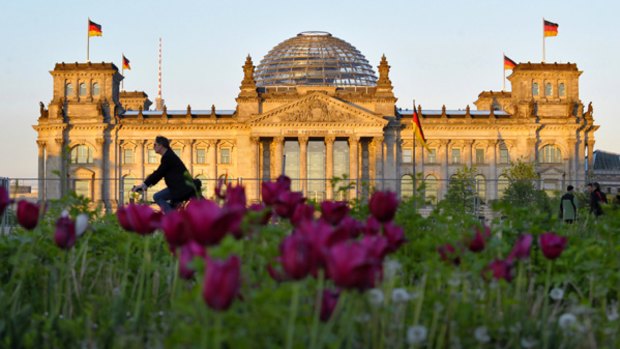
Bloc party ... a rider passes the Reichstag building, Germany's lower house of parliament.Credit: AFP
Berlin has shaped its future by embracing its past. Once sliced apart, the city has healed itself during the past two decades and this month celebrates the 20th anniversary of the fall of the Berlin Wall and the reunification of Germany. To understand the history that has shaped this modern metropolis, here are five things you can't miss.
Berlin Wall
Running my hand along the remains of the Berlin Wall gave me pins and needles: there's the heave and shudder of a history not yet settled. The wall has left a visible scar on the city in the form of two white cobblestone lines running through the streets, marking the place where it once stood. Parts of it still stand.
The most popular with visitors is the polished East Side Gallery, where the wall has been transformed into a 1.3-kilometre canvas for artists, the most well known being the iconic cartoon image of The Mortal Kiss.
A more sombre section is located in Bernauer Strasse, where a portion of the dead zone, the no-man's land that separated East and West Berlin, has also been preserved. The main memorial to those who died attempting to cross the wall is here, although unofficial memorials erected by family and friends can be found throughout the city.
See berlin.de/mauer/index.en.html.
Checkpoint Charlie Museum
Established in 1962 next to the border crossing nicknamed Checkpoint Charlie, the building was used as part of the resistance, with escape-helpers using a small window to observe movement at the border.
The museum tells of the human story behind the separation of East and West Germany. It chronicles both successful and unsuccessful escape attempts from East to West. The two-storey museum is a treasure trove of ingenious artefacts used to escape the East, including modified cars, suitcases with secret compartments, home-made submarines and even gyrocopters.
While the museum has some quirky and heart-warming stories, it could almost be called the "museum of courage" as it highlights the savage, tragic nature of trying to cross the border during the Cold War.
The museum is open daily from 9am-10pm at Friedrichstrasse 43-45. See mauermuseum.de.
Holocaust Memorial
Its formal name is the Memorial to the Murdered Jews of Europe and it is controversial. More than 2000 grey, oblong blocks rise and fall like waves, some towering above your head, others below your knees, in even rows on uneven ground.
There is no significance to the number of blocks or the way they are set out. The memorial does not have any signage or writing, save for an unmarked underground information centre that was a design compromise by the original architect, Peter Eisenman.
The memorial is a riddle and that is its success: it encourages you to think about why it's there and reflect on its meaning. Each visitor connects with the memorial in a different way, some finding it physically destabilising, others questioning why it commemorates only Jews and not the millions of gypsies, homosexuals and disabled people killed during World War II.
The memorial is open daily, on Cora-Berliner-Strasse, near the Brandenburg Gate. See www.holocaust-mahnmal.de/en.
Reichstag building
This is where Berlin's past meets its future. A 100-year-old sandstone shell that housed the first parliament of the German Empire, it has been rebuilt into a modern building and tourist attraction.
The highlight is the sleek steel-and-glass cupola offering 180-degree views of Berlin. Visitors take a lift to a platform and are given a free audio guide that directs them to major landmarks where historical events took place. The cupola itself, which collects water, heats the building and provides lighting to the parliament.
The main floor of the platform is the glass roof of the actual German parliament, designed as a physical metaphor: government is transparent, people are on top. Above all other attractions in Berlin, the Reichstag physically reflects where the reunified city is aiming to go: acknowledging its fractured history while moving toward a unified future.
The dome is open from 8am to midnight, but is closed on selected days during the year. See bundestag.de/htdocs_e/visits/index.jsp.
Historic walking tour
It is chilling to be on a quiet residential street, reading a small information board that states you are standing on the exact spot where Adolf Hitler committed suicide in 1945. Berlin's cityscape was largely destroyed by the end of World War II, but there are still glimpses of the past to be found. A walking tour is one of the best ways to understand how the city was physically affected by war.
Most tours begin with the former Nazi government district, where a few sharp-edged buildings designed by Albert Speer, Hitler's architect, still stand. A walking tour may also visit one of the few remaining guard towers in Berlin, as well as sections of the wall, Checkpoint Charlie and the infamous Wilhelmstrasse, where Hitler's top bureaucrats had their offices.
A walking tour not only gives you context about the forces that shaped this city, but also a chance to see how the city has physically moved beyond the shadows of its past to become a modern metropolis of the future.
See berlinwalks.com.
The writer travelled courtesy of Topdeck.
Sign up for the Traveller Deals newsletter
Get exclusive travel deals delivered straight to your inbox. Sign up now.